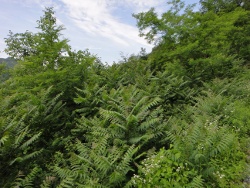InvasEVe:
Large-scale assessment of alien plant invasions
in European vegetation
The onset of globalisation has lead to a massive migration of plants to areas outside their native range, often with detrimental consequences for the environment and the economy in the new area. The management of invasive alien plants has recently been declared as one of six key objectives of the EU biodiversity strategy. However, little is known about the levels of alien plant invasion across European Vegetation Types.
Project aims
This project will be the first to analyze alien plant invasion across European vegetation types. It will focus on invasion patterns in forests for which good data coverage exists. Its particular aims are (1) to identify forest types most vulnerable to invasions, (2) to clarify how environmental variables influence the levels of invasion, and (3) to map the levels of invasion for the most common forest types in Europe. The backbone of the study will be the recently established European Vegetation Archive (EVA) – the largest vegetation data compilation from European countries. The project will also establish close ties with the checklist of alien species in Europe (DAISIE database).

Ailanthus altissima is one of several invasive alien plants in
European forests.
Photo courtesy: Christian Berg.
Coordination team
Main investigator: Viktoria Wagner (Masaryk University, Czech Republic)
Project supervisor: Milan Chytrý (Masaryk University, Czech Republic)
Technical support: Borja Jiménez-Alfaro, Ilona Knollová (Masaryk University, Czech Republic)
Collaborators: Jan Pergl (Academy of Sciences, Czech Republic), Petr Pyšek (Academy of Sciences, Charles University, Czech Republic)
Data contributors: names to be posted, soon
Project duration
May 2014 – October 2016
Funding
The project is financed from the SoMoPro II programme. The research leading to this result has acquired a financial grant from the People Programme (Marie Curie action) of the Seventh Framework Programme of EU according to the REA Grant Agreement No. 291782. The research is further co-financed by the South-Moravian Region.
Libility
This homepage reflects only the author´s views and the Union is not liable for any use that may be made of the information contained therein.

